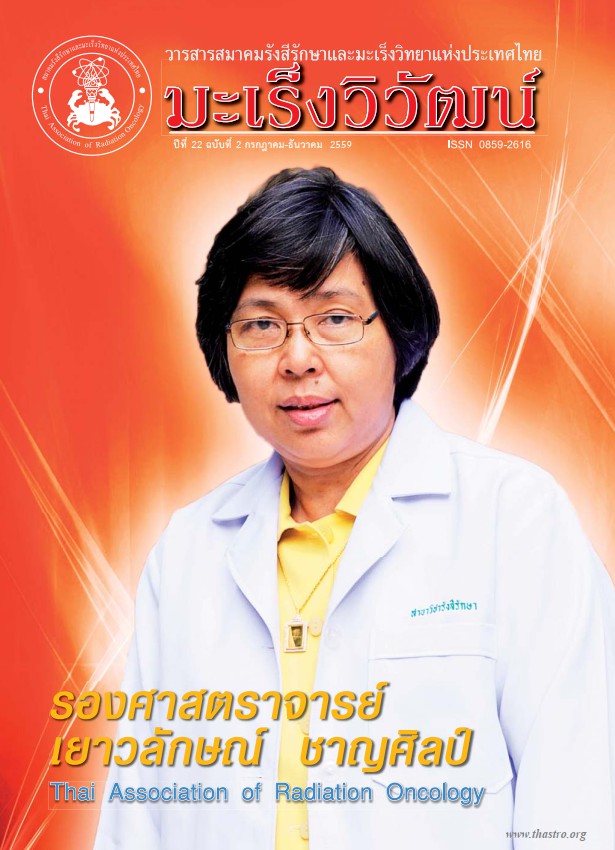The Impact of overall treatment time on treatment outcome of radiotherapy in cervical cancer
Keywords:
brachytherapy, local control rate, overall survival rate, overall treatment time, radiotherapyAbstract
Backgrounds The adverse effect on treatment outcome for prolongation of overall treatment time (OTT) in radiotherapy has been reported in some studies. Objective This study aimed to clarify the impact of OTT on the treatment outcome of radiotherapy in cervical cancer. Materials and methods The records of 130 cervical cancer patients with squamous cell carcinoma (stage IB to IVA) underwent definitive radiotherapy in year 2009-2013 were retrospective studied. The patients received the totally EQD2 cumulative dose at point A which consisted of external beam radiotherapy of 44 Gy whole pelvic then midline block to 50 Gy, followed by parametrium boost to 56 Gy and Ir-192 intracavitary brachytherapy with point A dose of 7 Gy for four fractions. The patients were separated into 2 groups based on OTT recommended by American Brachytherapy Society, OTT ≤ 56 day (group 1) and > 56 day (group 2). Kaplan-Meier and Log-rank were used to test for the difference between 2 groups. Cox regression was used for univariate and multivariate analysis (MVA) to identify the prognostic factor. Results For the studied group, OTT ranged 44-88 day and EQD2 ranged 83.6-86.1 Gy. Local control rate (p = 1.000), distant metastasis free survival rate (p = 0.923), disease Free Survival (DFS) (p = 0.734), cause specific survival (p = 0.410) and overall Survival (OS) (p = 1.000) were not significantly different between 2 groups. MVA identified initial tumor size as the prognostic factor of DFS (p = 0.016) and stage for OS (p = 0.007). Conclusions Our results revealed that there was no impact of OTT on the treatment outcome and survival rate. Tumor size greater than 4 cm was the prognostic factor of DFS and stage for OS.
References
Chitapanarux I, Srisukho S. Cancer incidence and mortality in Chiang Mai, Thailand. 2011. Chiang Mai: Academic publishing unit;2014.
จตุพล ศรีสมบูรณ์.มะเร็งปากมดลูก การวินิจฉัยและการรักษา.พี.บี.ฟอเรนบุ๊คส์ เซ็นเตอร์: กรุงเทพฯ;2557.
Nag S, Erickson B, Thomadsen B, Orton C, Demanes JD, Petereit D. The American brachytherapy society recommendations for high-dose-rate brachytherapy for carcinoma of the cervix. Int J Radiat Oncol Biol Phys 2000;48:201-11.
ICRU report 38 (1985) Dose and volume specification for reporting intracavitary therapy in gynecology. Bethesda, MD: International Commission on Radiation Unit and Measurement: 1-20.
Potter R, Haie-Meder C, Limbergen EV, Barillot I, De Brabandere M, Dimopoulos J, et al. Recommendations from gynaecological (GYN) GEC ESTRO working group (II): Concepts and terms in 3D image-based treatment planning in cervix cancer brachytherapy-3D dose volume parameters and aspects of 3D image-based anatomy, radiation physics, radiobiology. Radiother Oncol 2006;78:67-77.
Jones B, Dale RG, Deehan C, Hopkins KI, Morgan DAL. The role of biologically effective dose (BED) in clinical oncology. Clin Oncol 2001;13:71-81.
Withers HR, Taylor JMG, Maciejewski B. The hazard of accelerated tumour clonogen repopulation during radiotherapy. Acta Oncol 1988;27:131–46.
อรุณ จิรวัฒน์กุล. สถิติทางวิทยาศาสตร์สุขภาพเพื่อการวิจัย (Statistic for health science research). พิมพ์ครั้งที่ 1.กรุงเทพ: วิทยพัฒน์; 2552.
Wang CJ, Huang EY, Sun LM, Chen HC, Fang FM, Hsu HC, et al. Clinical comparison of two linear-quadratic model-based isoeffect fractionation schemes of high-dose-rate intracavitary brachytherapy for cervical cancer. Int J Radiat Oncol Biol Phys 2004;59:179-89.
Toita T, Kakinohana Y, Ogawa K, Adachi G, Moramizato H, Nagai Y, et al. Combination external beam radiotherapy and high-dose-rate intracavitary brachytherapy for uterine cervical cancer: Analysis of dose and fractionation schedule. Int J Radiat Oncol Biol Phys 2003;56:1344-53.
Chen SW, Liang JA, Yang SN, Ko HL, Lin FJ. The adverse effect of treatment prolongation in cervical cancer by high-dose-rate intracavitary brachytherapy. Radiother Oncol 2003;67:69-76.
Ferrigno R, Ribeito dos Santos Novaes PE, Pellizzon ACA, Conte Maia MA, Fogarolli RC, Gentil AC, et al. High-dose-rate brachytherapy in the treatment of uterine cervix cancer. Analysis of dose effectiveness and late complications. Int J Radiat Oncol Biol Phys 2001;50:1123-35.
Chandel SS, Singh KK, Nigam AK, Baghel RS. Role of twice weekly HDR-brachytherapy in management of carcinoma of uterine cervix-experience of Rural centre in India. Global Journals Inc 2013;13:32-8.
Gerbaulet A, Potter R, Haie-Meder C. Cervix cancer. In:Gerbaulet A, Potter R, Mazeron JJ, Meertens H, Limbergen EV, editors. The GEC ESTRO handbook of brachytherapy. 1st ed. Leuven: ACCO; 2002. 301-64.
Fyles AW, Pintilie M, Kirkbride P, Levin W, Manchul LA, Rawlings GA, et al. Prognostic factors in patients with cervix cancer treated by radiation therapy: results of a multiple regression analysis. Radiother Oncol 1995;35:107-17.
Downloads
Published
How to Cite
Issue
Section
License
บทความที่ได้รับการตีพิมพ์เป็นลิขสิทธิ์ของวารสารมะเร็งวิวัฒน์ ข้อความที่ปรากฏในบทความแต่ละเรื่องในวารสารวิชาการเล่มนี้เป็นความคิดเห็นส่วนตัวของผู้เขียนแต่ละท่านไม่เกี่ยวข้องกับ และบุคคลากรท่านอื่น ๆ ใน สมาคมฯ แต่อย่างใด ความรับผิดชอบองค์ประกอบทั้งหมดของบทความแต่ละเรื่องเป็นของผู้เขียนแต่ละท่าน หากมีความผิดพลาดใดๆ ผู้เขียนแต่ละท่านจะรับผิดชอบบทความของตนเองแต่ผู้เดียว




